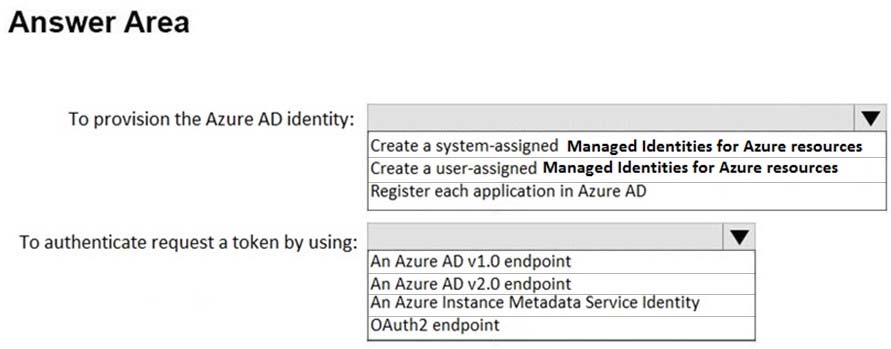

HOTSPOT -
You have five .NET Core applications that run on 10 Azure virtual machines in the same subscription.
You need to recommend a solution to ensure that the applications can authenticate by using the same Azure Active Directory (Azure AD) identity. The solution must meet the following requirements:
✑ Ensure that the applications can authenticate only when running on the 10 virtual machines.
✑ Minimize administrative effort.
What should you include in the recommendation? To answer, select the appropriate options in the answer area.
NOTE: Each correct selection is worth one point.
Hot Area:

kewl
Highly Voted 5 years, 6 months agoonlyfunmails
5 years, 5 months agopinchocr
5 years, 2 months agotartar
4 years, 9 months agompknz
5 years, 4 months agodtvAzh
5 years, 2 months agoSaurabhAzure
5 years, 4 months agoMoon
Highly Voted 5 years, 4 months agoglam
Most Recent 4 years, 4 months agosanketshah
4 years, 5 months agosejalo
4 years, 4 months agomultcloud
4 years, 9 months agonesith
4 years, 6 months agoAnju17
4 years, 9 months agoHisagenda
4 years, 9 months agoDuyons
4 years, 9 months agotmurfet
4 years, 9 months agoKCjoe
4 years, 10 months agoduytran216
4 years, 10 months ago[Removed]
4 years, 11 months agogboyega
4 years, 11 months agoFaizy
4 years, 10 months agogboyega
4 years, 11 months agoNeetiniti
4 years, 11 months agolearnazure63
4 years, 12 months agoPrash85
4 years, 12 months ago